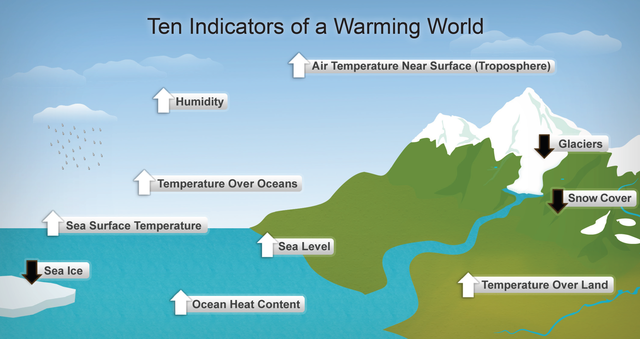 |
This is a file from the Wikimedia Commons. Information from its description page there is shown below.
Commons is a freely licensed media file repository. You can help.
|
Summary
| Description |
English: This diagram shows ten indicators of global warming: Seven of these indicators would be expected to increase in a warming world. These are:
- Air temperature near surface ( troposphere)
- Specific humidity
- Ocean heat content
- Sea-surface temperature
- Temperature over the oceans
- Temperature over the land
Observations show that these 7 indicators are, in fact, increasing. The following three indicators would be expected to decrease in a warming world. These are:
- Sea-ice (September Arctic sea-ice extent)
Observations show that these 3 indicators are, in fact, decreasing.
From page 2 of the cited public-domain source: "A comprehensive review of key climate indicators confirms the world is warming and the past decade was the warmest on record. More than 300 scientists from 48 countries analyzed data on 37 climate indicators, including sea ice, glaciers and air temperatures. A more detailed review of 10 of these indicators, selected because they are clearly and directly related to surface temperatures, all tell the same story: global warming is undeniable. For example, the surface air temperature record is compiled from weather stations around the world, and analyses of those temperatures from four different institutions show an unmistakable upward trend across the globe. But even without those measurements, nine other major indicators of climate change agree: the earth is growing warmer and has been for more than three decades.
A warmer climate means higher sea level, humidity and temperatures in the air and ocean. A warmer climate also means less snow cover, melting Arctic sea ice and shrinking glaciers." See also effects of global warming.
|
| Date |
July 2010 |
| Source |
State of the Climate in 2009: Supplemental and Summary Materials: Report at a Glance: Highlights, US National Oceanic and Atmospheric Administration: National Climatic Data Centre, http://www.ncdc.noaa.gov/bams-state-of-the-climate/2009.php , page 2. |
| Author |
US National Oceanic and Atmospheric Administration: National Climatic Data Centre |
Permission
( Reusing this file) |
"As required by 17 U.S.C. 403, third parties producing copyrighted works consisting predominantly of the material produced by U.S. government agencies must provide notice with such work(s) identifying the U.S. Government material incorporated and stating that such material is not subject to copyright protection within the United States. The information on government web pages is in the public domain and not subject to copyright protection within the United States unless specifically annotated otherwise (copyright may be held elsewhere). Foreign copyrights may apply." http://www.ngdc.noaa.gov/ngdcinfo/privacy.html
|
Licensing
| Public domainPublic domainfalsefalse |
 |
This image is in the public domain because it contains materials that originally came from the U.S. National Oceanic and Atmospheric Administration, taken or made as part of an employee's official duties.
|
|
File usage
The following pages on Schools Wikipedia link to this image (list may be incomplete):
All five editions of Schools Wikipedia were compiled by SOS Childrens Villages. SOS Childrens Villages is an international children's charity, providing a good home and loving family to thousands of children who have lost their parents. We also work with communities to help vulnerable families stay together and raise children in the best possible environment. There are many ways to help with SOS Children.




